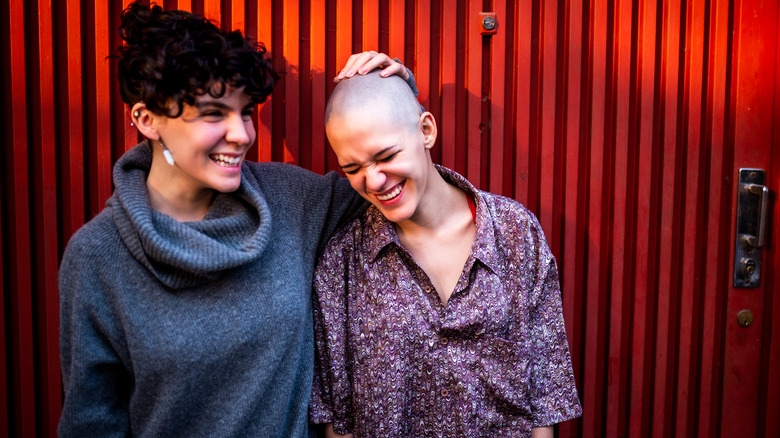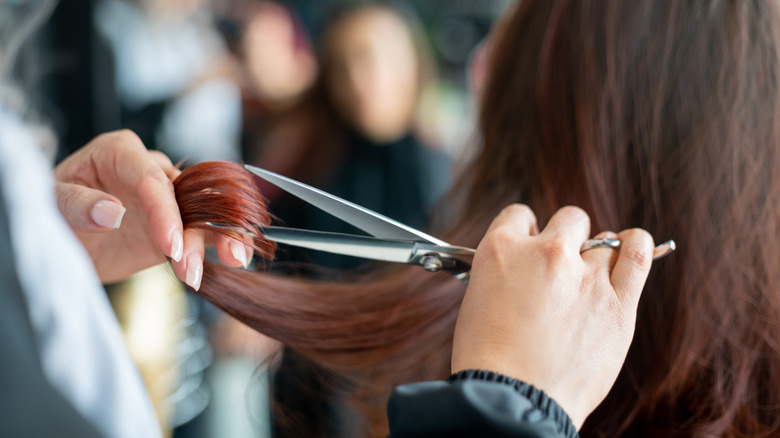What To Know If You're Planning To Donate Your Hair To People With Cancer
Despite major advances in science, cancer remains one of the biggest health issues facing humanity. According to the World Cancer Research Fund International, as of 2020, 18.1 million people were living with cancer worldwide. While each person's experience with cancer and its treatment is different, a 2019 study published in Indian Dermatology Online found that chemotherapy resulted in hair loss in 65% of people. It's a side effect that, although common, is an emotional one, especially for those who have always had hair.
"Everything about illness and cancer is adjusting to a new life, routine, and expectations," clinical social worker at LLU Cancer Center Gina Morales, LCSW told Loma Linda University Health News. "Many are just yearning for normalcy. But, because hair loss is visible, it can feel like another reminder that things aren't the normal they once knew."
Because of this, if you're thinking about getting a haircut — short hair is the trend for 2024, after all — it's worth donating those locks so cancer patients can have custom-made wigs of real hair. Think of it this way: if you're going to chop it anyway, it's better off being used to make someone feel good and empowered, as opposed to being swept off the floor and thrown out.
Choose an organization
When it comes to donating hair, there are many organizations to choose from. For example, Locks of Love and Children with Hair Loss are charities that create wigs for children up to age 21, and not just for cancer-related hair loss, but for those with genetic conditions, burns, or anything else that might result in one needing a wig. Wigs for Kids is another organization that creates wigs for kids under 18 years of age.
"We activated the donation program over 30 years ago when I was consulting a woman in my private practice who was going to go through chemotherapy for cancer," scalp specialist and the founder of Wigs for Kids Jeffrey Paul told Byrdie. "Her daughter was with her, whose 40 inches of beautiful blonde hair was her crown and pride, and asked me at the end of the consultation with tears in her eyes [...] if she could cut her hair to give to her mother for her wig." As Paul explained there was no such program at the time, but the experience made him realize there needed to be. "That was the 'seed' of the idea to launch the Wigs for Kids Ponytail Donation Program," said Paul.
If you'd like to donate to an organization that works with adults, then Hair We Share is a great choice. If you want to see your hair going to a woman who needs a wig due to chemotherapy, then Pink Heart Funds is for you.
Read the guidelines and donation requirements
Before going to the salon, familiarize yourself with the guidelines of exactly how to cut your hair and prepare it for donation. Although there are general requirements across all the organizations, each one has its specifications, especially regarding length and treated hair.
If you're donating to Locks of Love, your hair needs to be at least 10 inches long — curly hair should be stretched to reach this length. Hair We Share prefers hair that's 12 inches in length but will accept eight inches for shorter wigs, as will Pink Hearts Fund. Wigs for Kids asks that hair be, ideally, 14 inches or longer, but they'll take 12 inches.
In all cases, the hair should be washed and thoroughly dried, then put in a braid or ponytail that's cut and put aside for packaging. Although some organizations accept permed and/or dyed hair, highlighted, balayage, and similar lightened hair are not accepted. "[Because it compromises the integrity of the hair strength [and] the hair will most likely not withstand the ventilating process," Hair We Share co-founder and wig designer Suzanne Chimera told Good Housekeeping. "If it does withstand this process, we run the risk of it shedding from the wig as the recipient is wearing it." Also, if you do have dyed hair, the color needs to be natural if it's to be accepted for donation. In other words, as much as your hot pink and bleached locks are a lot of fun, they're not wig-friendly.
Chop your hair
As long as you have your hair in a ponytail or braid with bands at each end to keep it from falling all over the place, anyone can cut your hair for donation. Unless, of course, the organization that you're donating to has specifications about how it should be parted before it's cut. "If you don't section it into quadrants, there are too many disparities in length," hairstylist Jasmine Burnside told Makeup by L'Oréal. "The hair ties also keep every section nice, tidy, and organized ... You want someone experienced in sectioning and cutting the hair precisely because if you only have 12 inches to give, you want to make sure you're not wasting it."
You also don't want any hair that you'll be donating to touch the ground. For example, if you go in for a cut and realize you have inches upon inches piled up on the floor, it's way too late to donate it at that point. Leave it there, and prepare in advance next time you're getting a bunch of inches chopped off.
Package and send
Once your hair has been cut — and you know it's completely dry so it's not going to get moldy — place it in a plastic bag for safe keeping until you can get to the post office. While each organization is a bit different in how they want to receive hair donations (some want regular envelopes, others want padded ones and tissue paper) the plastic bag is always part of the equation, as is a completed donation form.
Although once you've sent your donation, it's pretty much out of your hands, some organizations, like Hair We Share, offer tracking programs for a fee so you can watch the process of your hair becoming a wig and finding a new home with someone who needs it. "We're excited to continue our mission to provide the highest quality of hair replacements to as many children as possible who are living with medical hair loss," president of Locks of Love Madonna Coffman told Today.
If you're willing to part with your hair, there is no greater gift than to donate it to a charity that's going to give a cancer patient, or anyone else with medically-induced hair loss, the opportunity to feel a bit more normal again. It's one of the most altruistic things you can do.




